1993 BUICK SKYLARK lock
[x] Cancel search: lockPage 156 of 306

When you drive into a curve at night, it's harder to see
the road ahead
of you because it bends away from the
straight beams
of your lights. This is one good reason to
drive slower.
Steering in Emergencies
There are times when steering can be more effective
than braking. For example,
you come over a hill and
find a truck stopped in your lane, or a car suddenly pulls
out from nowhere, or a child darts out from between
parked cars and stops right in front
Qf you. You can
avoid these problems by braking
-- if you can stop in
time. But sometimes you can't; there isn't room. That's
the time for evasive action
-- steering around the
problem.
Your Buick can perform very well in emergencies like
these. First apply your brakes. It is better to remove as
much speed as you can from a possible collision. Then
steer around the problem, to the left or right depending
on the space available.
An emergency like this requires close attention and a
quick decision.
If you are holding the steering wheel at
the recommended
9 and 3 o'clock positions, you can
turn it a full
180 degrees very quickly without removing
either hand. But you have to act fast, steer quickly, and just as
quickly straighten the wheel once you have
avoided the object. You must then be prepared to steer
back to your original lane and then brake to a controlled
stop.
Depending
on your speed, this can be rather violent for
an unprepared driver. This is one of the reasons driving
experts recommend that you use your safety belts and
keep both hands on the steering wheel.
-1
3'
The fact that such emergency situations are always
possible is a good
reason to practice defensive driving at
all times.
155
Page 160 of 306
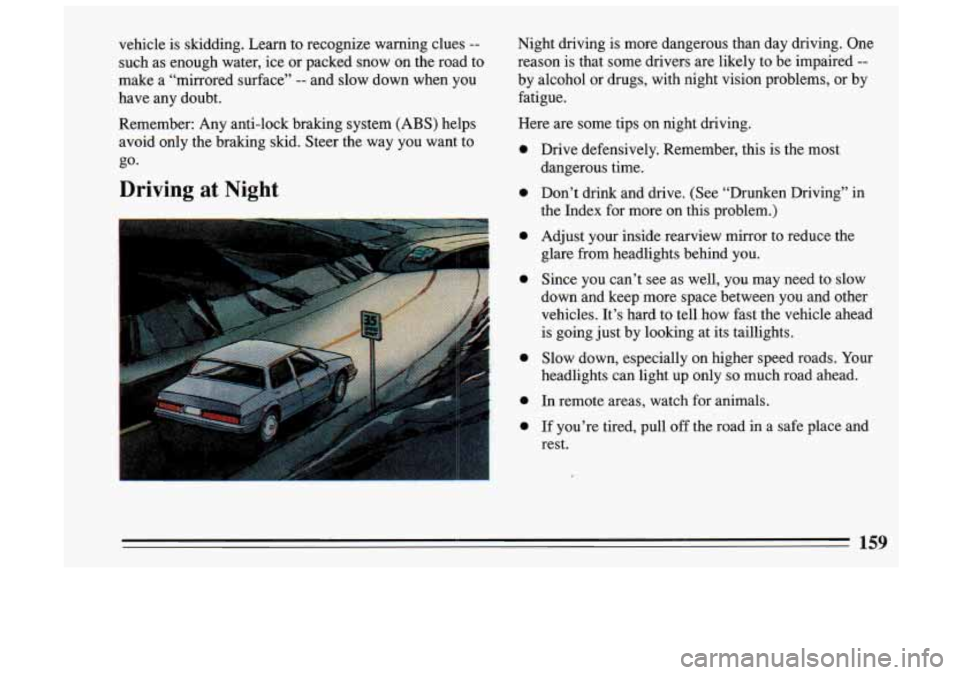
vehicle is skidding. Learn to recognize warning clues --
such as enough water, ice or packed snow on the road to
make a “mirrored surface”
-- and slow down when you
have any doubt.
Remember: Any anti-lock braking system (ABS) helps avoid only the braking skid. Steer the way you want to
go.
Driving at Night
Night driving is more dangerous than day driving. One
reason is that some drivers are likely to be impaired
--
by alcohol or drugs, with night vision problems, or by
fatigue.
Here are some tips on night driving.
0
0 0
0
0 Drive defensively. Remember, this is the most
dangerous time. Don’t drink and drive. (See “Drunken Driving” in
the Index for more
on this problem.)
Adjust your inside rearview mirror to reduce the glare from headlights behind you.
Since you can’t see as well, you may need to slow
down and keep more space between you and other vehicles. It’s hard to tell how fast the vehicle ahead
is going just by looking at its taillights.
Slow down, especially on higher speed roads.
Your
headlights can light up only’s0 much road ahead.
In remote areas, watch for animals.
If you’re tired, pull
off the road in a safe place and
rest.
Page 161 of 306

Avoid staring directly into the approaching lights. If
there is a line of opposing traffic, make occasional
glances over the line of headlights to make certain that
one of the vehicles isn’t starting to move into your lane.
Once you are past the bright lights, give your eyes time
to readjust before resuming speed.
High Beams
If the vehicle approaching you has its high beams on,
signal by flicking yours to high and then back to low
beam. This is the usual signal to lower the headlight
beams. If the other driver still doesn’t lower the beams,
resist the temptation to put your high beams on. This
only makes two half-blinded drivers.
On
a freeway, use your high beams only in remote areas
where you won’t impair approaching drivers. In some
places, like cities, using high beams is illegal.
I
Night Vision
No one can see as well at night as in the daytime. But as
we get older these differences increase. A 50-year-old
driver may require
at least twice as much light to see the
same thing at night as a 20-year-old.
What you do in the daytime can also affect your night
vision. For example,
if you spend the day @ bright
sunshine you are wise to wear sunglasses. ,Your eyes will
have less trouble adjusting to night.
But
if you’re driving, don’t wear sunglasses at night.
They may cut down on glare from headlights, but they
also make a lot of things invisible that should remain
visible
- such as parked cars, obstacles, pedestrians, or
even trains blocking railway crossings. You may want to
put on your sunglasses after
you have pulled into a
brightly-lighted service or refreshment area. Eyes
shielded from that glare may adjust more quickly to
darkness back on the road: But be sure to remove your
sunglasses before you leave the service area.
You can be temporarily blinded by approaching lights.
It can take a second or two, or even several seconds, for
your eyes to readjust to the dark. When you are faced
with severe glare (as from a driver who doesn’t lower
the high beams, or
a vehicle with misaimed headlights),
slow down a little.
..
When you follow another vehicle on a freeway or
highway, use low beams. True, most vehicles now have
day-night mirrors that enable the driver to reduce glare. But outside mirrors are not
of this type and. rh beams
from behind can bother the driver ahead.
160
Page 175 of 306
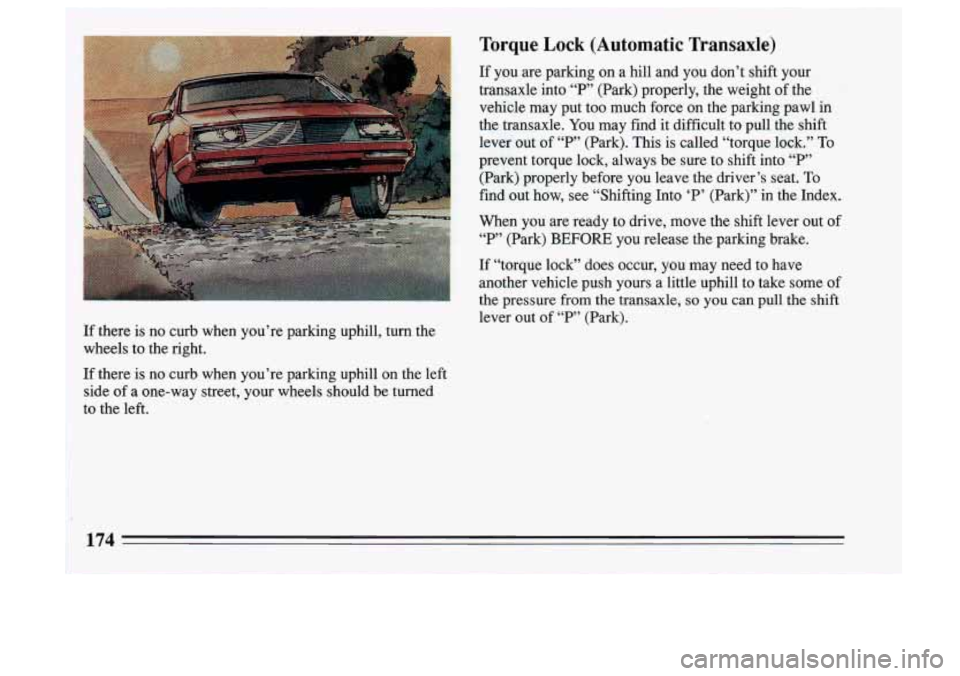
If there is no curb when you’re parking uphill, turn the
wheels to the right.
If there is no curb when you’re parking uphill on the left
side of a one-way street, your wheels should be turned
to the left.
Torque Lock (Automatic Transaxle)
If you are parking on a hill and you don’t shift your
transaxle into“‘F” (Park) properly, the weight
of the
vehicle may put too much force on the parking pawl in
the transaxle. You may find it difficult to pull the shift
lever out of
T“ (Park). This is called “torque lock.” To
prevent torque lock, always be sure to shift into “P”
(Park) properly before you leave the driver’s seat. To
find out how, see “Shifting Into ‘P’ (Park)” in t\
he Index.
When you are ready to drive, move the shift lever out of
“P” (Park) BEFORE you release the parking brake.
If “torque lock” does occur, you may need to have
another vehicle push yours a little uphill to take some of
the pressure
from the transaxle, so you can pull the shift
lever out of
“P” (Park).
174
Page 178 of 306
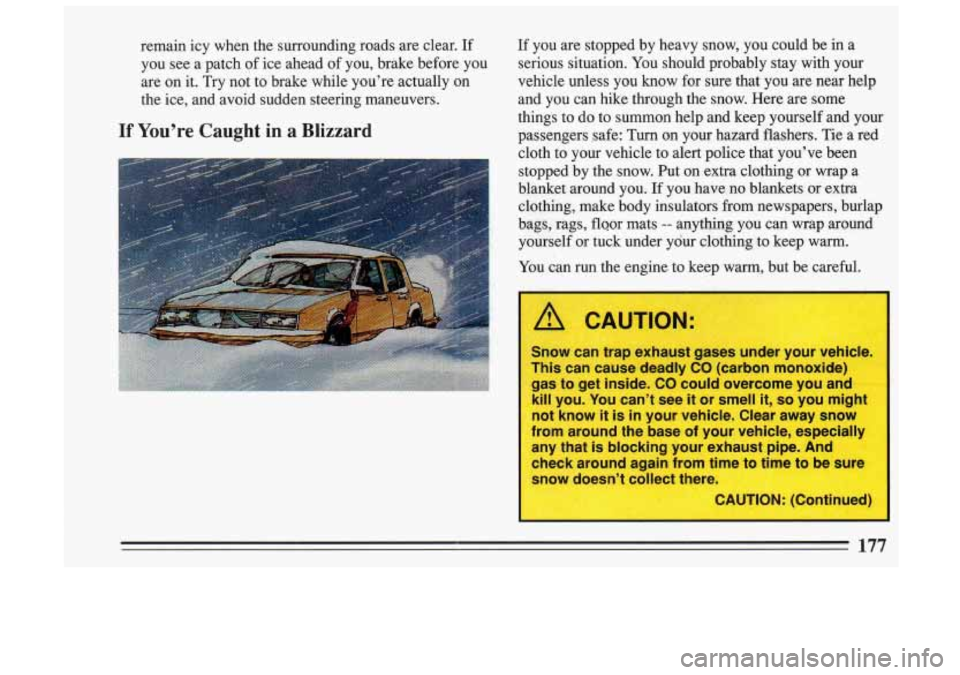
remain icy when the surrounding roads are clear. If
you see a patch of ice ahead of you, brake before you
are on it. Try not to brake while you’re actually on
the ice, and avoid sudden steering maneuvers.
If You’re Caught in a Blizzard
If you are stopped by heavy snow, you could be in a
serious situation. You should probably stay with your
vehicle unless you know for sure that you are near help
and you can hike through the snow. Here are some
things to do to summon help and keep yourself and your
passengers .safe: Turn on your hazard flashers. Tie a red cloth to your vehicle to alert police that you’ve been
stopped by the snow. Put on extra clothing
or wrap a
blanket around you.
If you have no blankets or extra
clothing, make body insulators from newspapers, burlap
bags, rags, flsor mats
-- anything you can wrap around
yourself
or tuck under your clothing to keep warm. I
You can run the engine to keep warm, but be careful.
I
A CAUTION:
dnow can trap exhaust gases under your vehicle
This can cause deadly
CO (carbon monoxide)
gas to get inside. CO could overcome you and
kill you. You can’t see
it or smell it, so you might
not know
it is in your vehicle. Clear away snow
from around the base of your vehicle, especia”--
any that
is blocking your exhaust pipe. And
check around again from time to time to be’su
snow doesn’t collect there.
177
Page 183 of 306
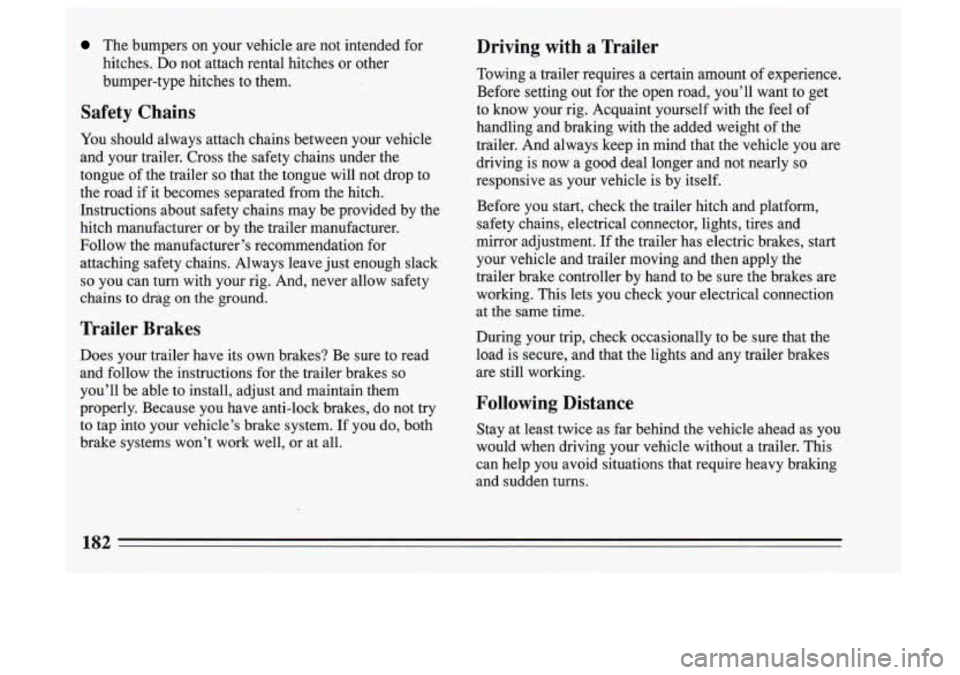
The bumpers on your vehicle are not intended for
hitches.
Do not attach rental hitches or other
bumper-type hitches to them.
Safety Chains
You should always attach chains between your vehicle
and. your trailer. Cross the safety chains under the
tongue of the trailer
so that the tongue will not drop to
the road if it becomes separated from the hitch.
Instructions about safety chains may be provided by the
hitch manufacturer or by the trailer manufacturer.
Follow the manufacturer’s recommendation for
attaching safety chains. Always leave just enough slack
so you can turn with your rig. And, never allow safety
chains to drag
on the ground.
Trailer Brakes
Does your trailer have its own brakes? Be sure to read
and follow the instructions for the trailer brakes
so
you’ll be able to install, adjust and maintain them
properly. Because you have anti-lock brakes, do not try
to tap into your vehicle’s brake system. ff you do, both
brake systems won’t work well, or at all.
Driving with a Trailer
Towing a trailer requires a certain amount of experience.
Before setting out for the open road, you’ll want to get
to know your rig. Acquaint yourself with the feel of
handling and braking with the added weight of the
trailer. And always keep in mind that the vehicle you are
driving is now a good deal longer and not.nearly
so
responsive as your vehicle is by itself.
Before you start, check the trailer hitch and platform,
safety chains, electrical connector, lights, tires and
mirror adjustment. If the trailer has electric brakes, start
your vehicle and trailer moving and then apply the
trailer brake controller by hand to be sure the brakes are working. This lets you check your electrical connection
at the same time.
During your trip, check occasionally to be sure that the
load
is secure, and that the lights and any trailer brakes
are still working.
Following Distance
Stay at least twice as far behind the vehicle ahead as you
would when driving your vehicle without a trailer. This
can help you avoid situations that require heavy braking
and sudden turns.
Page 195 of 306
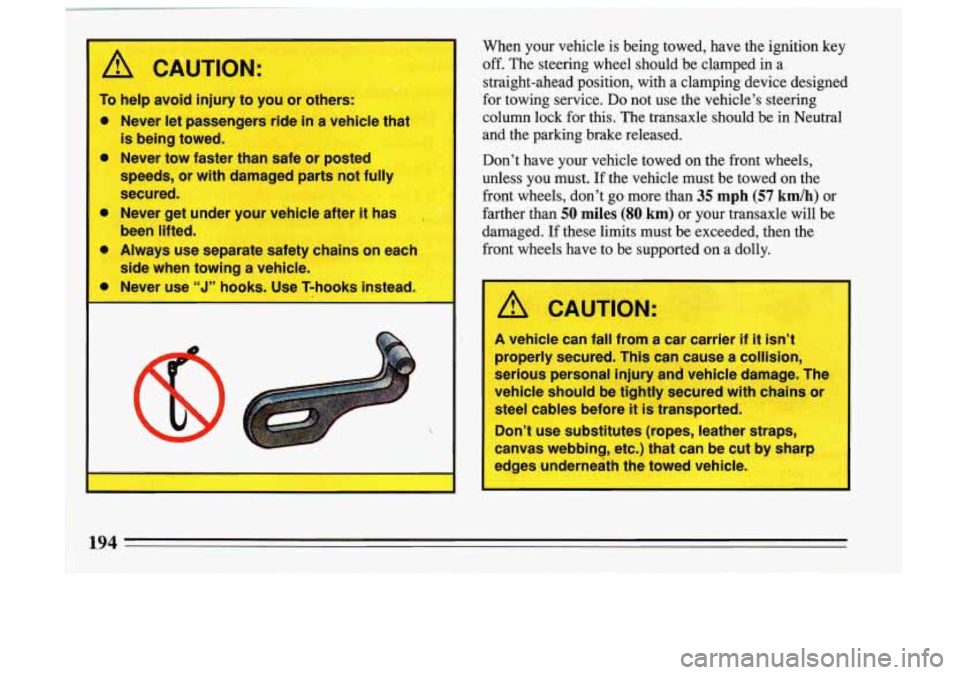
P-
When your vehicle is being towed, have the ignition key
off. The steering wheel should be clamped in a
straight-ahead position, with a clamping device designed
for towing service.
Do not use the vehicle’s steering
column lock for this. The transaxle should be in Neutral
and the parking brake released.
Don’t have your vehicle towed on the front wheels,
unless you must.
If the vehicle must be towed on the
front wheels, don’t go more than
35 mph (57 kmh) or
farther than
50 miles (80 km) or your transaxle will be
damaged. If these limits must be exceeded, then the
front wheels have to be supported on a dolly.
CAUTION:
I A vehicle 1 fall from a car cal t It isn’t
properly secured. This can cause a collision,
serious personal injury and vehicle damage. The
vehicle should be tightly secured with chains or
steel cables before
it is transported.
on’t use substitutes (ropes, leather straps,
canvas webbing, etc.) that can be cut by
sh; 1
I
I edges underneath the towed vehicle.
Page 211 of 306

Tighten the wheel nuts firmly in a crisscross sequence as
shown.
Lower the vehicle by rotating the wheel wrench
counterclockwise. Lower the jack completely.
210